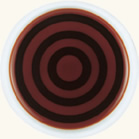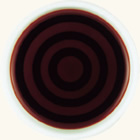
THERE ARE FIVE TYPES OF SOY SAUCE
-

- 濃 Koikuchi Shoyu (Common)
- This type accounts for around 80% of domestic production volume, and is the most general type. Other than saltiness, it has deep umami (savory flavor), rounded sweetness, refreshing acidity, and a bitterness that brings the tastes together. It is a widely usable, general-purpose condiment, usable in cooking or at table.
-

- 淡 Usukuchi Shoyu (Light color)
- This light-colored soy sauce originated in the Kansai region, and accounts for around 10% of domestic production volume. It uses around 10% more salt than common soy sauce, to make the fermentation and maturation processes more gradual. Its color and fragrance are reduced to bring out the original flavors of the ingredients. It is used in cooking dishes that preserve the color and taste of the ingredients, such as sugar-boiled stews and takiawase, in which ingredients are cooked separately but served together.
-

- 溜 Tamari Shoyu (Tamari)
- This soy sauce is mainly brewed in the Chubu region. It is characterized by thickness, dense umami, and a unique fragrance. It has long been called “sashimi tamari”, as it is commonly used at table with sushi and sashimi. When heated, it reveals a pleasing red tint, and it is also used in grilling, boiling in soy sauce, and the processing of products such as senbei rice crackers.
-

- 再 Saishikomi Shoyu (Refermented)
- This specially-produced soy sauce is produced in an area extending from the San-in region to Kyushu, centered in Yamaguchi prefecture. While other soy sauce is made by blending the koji with brine for brewing, this type is blended with other soy sauce, which is why it is called “refermented”. It is dense in color, flavor, and fragrance, and is also known as “sweet soy sauce”. It is mainly used at table, for flavoring sashimi, sushi, chilled tofu, and the like.
-

- 白 Shiro Shoyu (Extra light color)
- This pale amber-colored soy sauce, even lighter than light color soy sauce, originated in the Hekinan district of Aichi prefecture. Its flavor is bland, but with a strong sweetness, and it has a unique fragrance. It is used in cooking dishes such as soups and chawanmushi egg custard, using its fragrance and light color. It is also used in rice crackers, pickles, and other foods.
BLENDING FOR DIVERSE FLAVORS
THE GROWING FAMILY OF SOY SAUCE-BASED CONDIMENTS

Dashi (stock-flavored) soy sauce
This is a simple and convenient condiment in which soy sauce is pre-blended with umami ingredients such as katsuobushi (dried bonito shavings) and kombu (kelp). Dashi soy sauce products have names such as “kombu soy sauce” and “Tosa soy sauce”, and they are widely used in cooking or applying to food at the meal table.

Tsuyu dipping sauces
These sauces combine soy sauce with mirin (sweet cooking rice wine), sugar, dashi stock, and other umami-producing ingredients. Products range from specialized sauces for noodles to general-purpose sauces that are used on stews, hot-pots, tempura dipping, and in other ways.

Tare basting sauces
These sauces combine flavoring ingredients, sugar, spices and the like with soy sauce. There are tare sauces for broiling, grilling, and yakitori skewered meats, for which the color and fragrance of soy sauce provide the finishing touch, various others for yakiniku grilled beef and as the base for sukiyaki, and more.

Ponzu soy sauce
Ponzu sauces combine soy sauce with brewed vinegar, with the addition of juice from highly-fragrant citrus fruits, or of savory flavors such as dashi stock, to create a wide range of products.

Soy sauce dressing
The addition of soy sauce to French dressing produces a Japanese-flavored dressing. It is widely used as a popular table condiment.